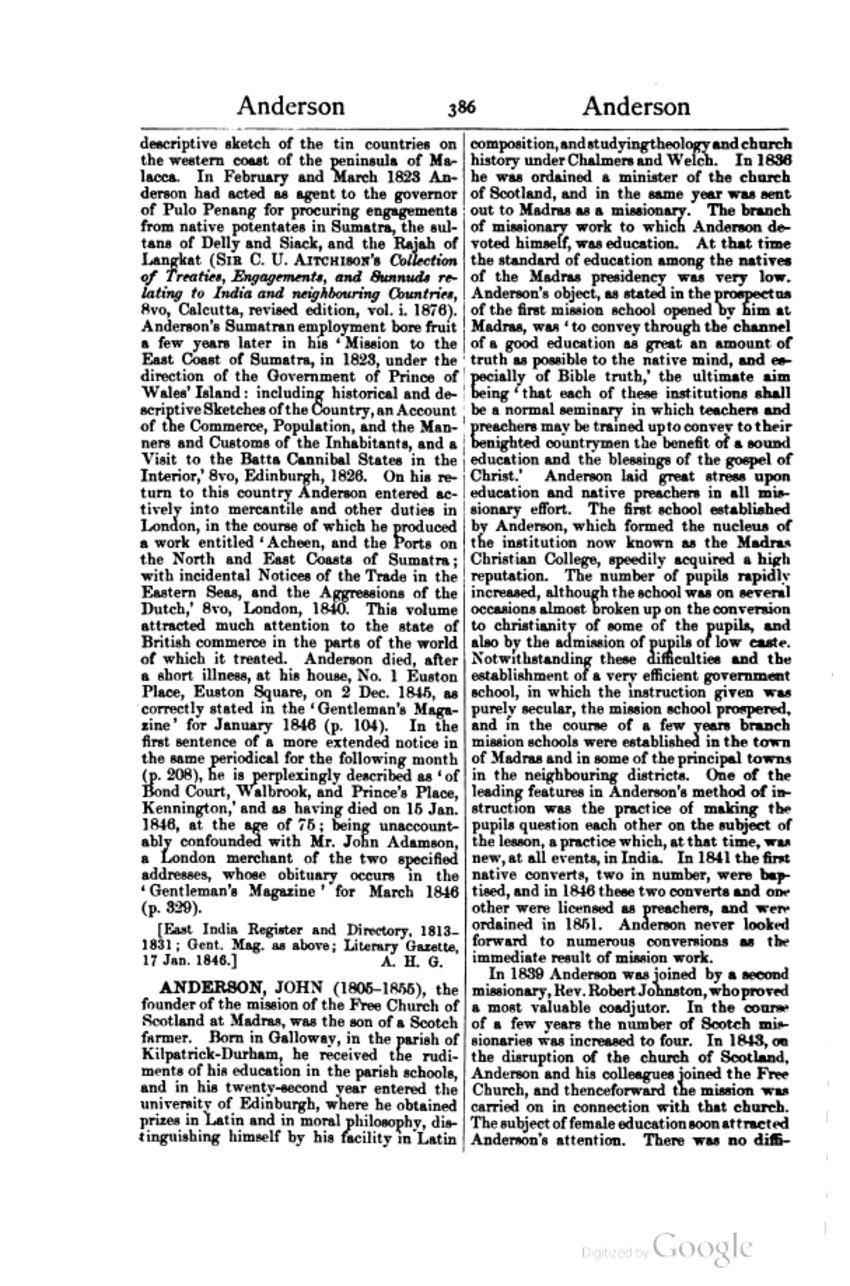descriptive sketch of the tin countries on the western coast of the peninsula of Malacca. In February and March 1823 Anderson had acted as agent to the governor of Pulo Penang for procuring engagements from native potentates in Sumatra, the sultans of Delly and Siack, and the Rajah of Langkat (Sir C. U. Aitchison's Collection of Treaties, Engagements, and Sunnuds relating to India and neighbouring Countries, 8vo, Calcutta, revised edition, vol. i. 1876). Anderson's Sumatran employment bore fruit a few years later in his ‘Mission to the East Coast of Sumatra, in 1823, under the direction of the Government of Prince of Wales' Island: including historical and descriptive Sketches of the Country, an Account of the Commerce, Population, and the Manners and Customs of the Inhabitants, and a Visit to the Batta Cannibal States in the Interior,’ 8vo, Edinburgh, 1826. On his return to this country Anderson entered actively into mercantile and other duties in London, in the course of which he produced a work entitled ‘Acheen, and the Ports on the North and East Coasts of Sumatra; with incidental Notices of the Trade in the Eastern Seas, and the Aggressions of the Dutch,’ 8vo, London, 1840. This volume attracted much attention to the state of British commerce in the parts of the world of which it treated. Anderson died, after a short illness, at his house, No. 1 Euston Place, Euston Square, on 2 Dec. 1845, as correctly stated in the ‘Gentleman's Magazine’ for January 1846 (p. 104). In the first sentence of a more extended notice in the same periodical for the following month (p. 208), he is perplexingly described as ‘of Bond Court, Walbrook, and Prince's Place, Kennington,’ and as having died on 15 Jan. 1846, at the age of 75; being unaccountably confounded with Mr. John Adamson, a London merchant of the two specified addresses, whose obituary occurs in the ‘Gentleman's Magazine’ for March 1846 (p. 329).
[East India Register and Directory, 1813–1831; Gent. Mag. as above; Literary Gazette, 17 Jan. 1846.]
ANDERSON, JOHN (1805–1855), the founder of the mission of the Free Church of Scotland at Madras, was the son of a Scotch farmer. Born in Galloway, in the parish of Kilpatrick-Durham, he received the rudiments of his education in the parish schools, and in his twenty-second year entered the university of Edinburgh, where he obtained prizes in Latin and in moral philosophy, distinguishing himself by his facility in Latin composition, and studying theology and church history under Chalmers and Welch. In 1836 he was ordained a minister of the church of Scotland, and in the same year was sent out to Madras as a missionary. The branch of missionary work to which Anderson devoted himself, was education. At that time the standard of education among the natives of the Madras presidency was very low. Anderson's object, as stated in the prospectus of the first mission school opened by him at Madras, was ‘to convey through the channel of a good education as great an amount of truth as possible to the native mind, and especially of Bible truth,’ the ultimate aim being ‘that each of these institutions shall be a normal seminary in which teachers and preachers may be trained up to convey to their benighted countrymen the benefit of a sound education and the blessings of the gospel of Christ.’ Anderson laid great stress upon education and native preachers in all missionary effort. The first school established by Anderson, which formed the nucleus of the institution now known as the Madras Christian College, speedily acquired a high reputation. The number of pupils rapidly increased, although the school was on several occasions almost broken up on the conversion to christianity of some of the pupils, and also by the admission of pupils of low caste. Notwithstanding these difficulties and the establishment of a very efficient government school, in which the instruction given was purely secular, the mission school prospered, and in the course of a few years branch mission schools were established in the town of Madras and in some of the principal towns in the neighbouring districts. One of the leading features in Anderson's method of instruction was the practice of making the pupils question each other on the subject of the lesson, a practice which, at that time, was new, at all events, in India. In 1841 the first native converts, two in number, were baptised, and in 1846 these two converts and one other were licensed as preachers, and were ordained in 1851. Anderson never looked forward to numerous conversions as the immediate result of mission work.
In 1839 Anderson was joined by a second missionary, Rev. Robert Johnston, who proved a most valuable coadjutor. In the course of a few years the number of Scotch missionaries was increased to four. In 1843, on the disruption of the church of Scotland, Anderson and his colleagues joined the Free Church, and thenceforward the mission was carried on in connection with that church. The subject of female education soon attracted Anderson's attention. There was no diffi-
